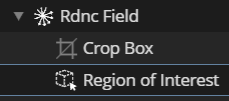The Rdnc Field node represents a radiance field model in the scene along with its training and rendering configuration.
After importing an image set and while training a radiance field, the Rdnc Field node is linked to an Image Set node. Once training has completed, the Image Set node is no longer needed to render the Rdnc Field and may be deleted from the scene.
Selects one of several machine learning models that will be used to train the radiance field.
See Training Configuration for more details.
If enabled, the resolution of input images will be reduced during training.
See Training Configuration for more details.
This value sets a limit for the number of Gaussian Splatting primitives (splats) that the training process will generate.
See Training Configuration for more details.
Checking this option improves the model quality and prevents artefacts when zooming away from the original camera positions.
See Training Configuration for more details.
This parameter lets you control the amount of data that is dedicated to reconstructing direction dependent colors in the scene.
See Training Configuration for more details.
Postshot can create a special sky model that may help to reduce such artefacts by projecting the environment onto a large sphere around the scene.
See Training Configuration for more details.
If enabled, the Translate, Rotate and Scale parameters specify a box that the training process will focus its resources on. This allows reducing the training time and maximizing the detail on objects inside the Region of Interest box.
 Instead of editing the values directly, you can also select the Region of Interest child node and use the Move, Rotate and Scale Viewport Tools to edit the Region of Interest box.
Instead of editing the values directly, you can also select the Region of Interest child node and use the Move, Rotate and Scale Viewport Tools to edit the Region of Interest box.
If checked, Postshot will stop training after the specified number of steps.
See Training Configuration for more details.
If this option is checked when saving the project, training can be continued from the current state at a later time.
Note that project files that include the training context are about three times larger.
This action resets the radiance field data such that it can be trained from scratch with different settings.
This field displays the version of Postshot that was used to train this radiance field.
Display basic statistics about the radiance field:
Display the degree of Spherical Harmonics coefficients that were used for this radiance field.
For more details see Training Configuration.
Displays the color space and transfer function used by the radiance field.
The following tables describes how Postshot chooses the color space and transfer function for the radiance field based on the the input images:
| Input Images | Radiance Field |
|---|---|
| sRGB D65, non-linear | sRGB D65, non-linear |
| sRGB D65, linear | sRGB D65, linear |
| Rec.2020, HLG | Rec.2020, HLG |
| ACES AP0, linear | ACEScg, linear |
| Other color spaces, linear | ACEScg, linear |
In particular, camera vendor specific color spaces used in RAW image formats are mapped to ACEScg for processing.
This parameter allows translating, rotating and scaling the radiance field model in the scene. Instead of editing the values directly, you can also use the Move, Rotate and Scale tools to control this scene transform.
Note that for the Viewport Tools to apply to the model, the corresponding Rdnc Field node must be selected in the Scene Tree.
See also Viewport Tools.
Estimates the direction pointing upward based on the image camera poses and rotates the radiance field model such that it aligns with the world up vector.
If camera poses have been imported from external sources, they often have an orientation that is effectively random. This option lets you quickly set the orientation to the estimated upward direction.
This action applies the current Transform parameter to the radiance field data and reset the Transform parameter to defaults. The orientation of the radiance field will remain the same in the Postshot scene. However, if the radiance field is exported, the transformation will be 'baked into' the data.
If enabled, the Translate, Rotate and Scale parameters specify a box that radiance field rendering will be bounded by. This allows the isolation of objects and the removal of background.
 Instead of editing the values directly, you can also select the Crop Box child node and use the Move, Rotate and Scale Viewport Tools to edit the Crop Box.
Instead of editing the values directly, you can also select the Crop Box child node and use the Move, Rotate and Scale Viewport Tools to edit the Crop Box.
The settings in this tab apply only to rendering, not to training of the radiance field.
Small Gaussian Splatting primitives with a radius below this value will not be rendered. This can improve rendering speed especially for very large models and very high frame rate requirements.
This value specifies what degree of Spherical Harmonics interpolation will be used to reconstruct direction dependent colors during rendering. Using a lower degree can improve rendering speed especially for very large models and very high frame rate requirements.
See also Max Sph. Hrm. Degree.
This parameter modulates the size of the Gaussian Splatting primitives. The default value of 1.0 renders the primitives at their original scale. Other values can be used for inspection or visual effects.
This parameter modulates the opacity of the Gaussian Splatting primitives. The default value of 1.0 renders the primitives at their original opacity. Other values can be used for inspection or visual effects.